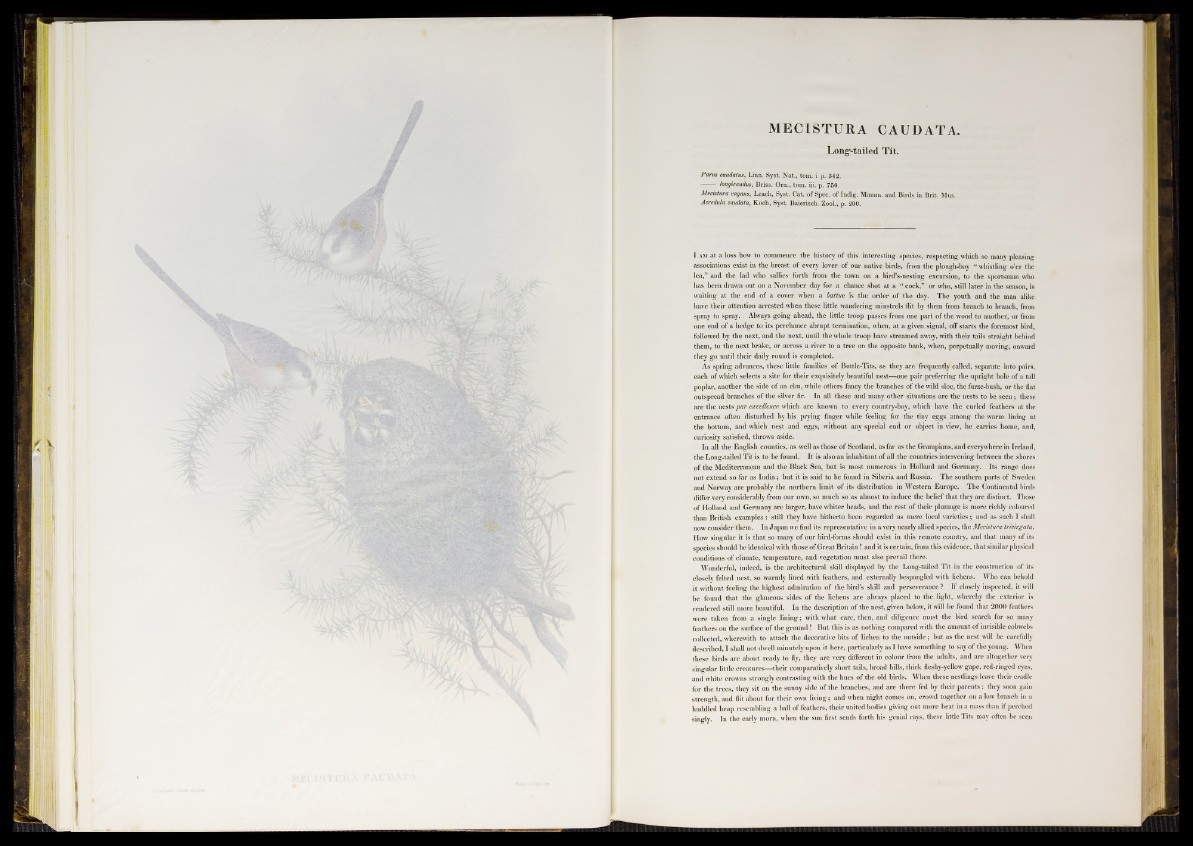
Long-tailed Tit.
Parus caudatus, Linn. Syst. Nat., tom. i p. 342.
longicaudus, Briss. Ora., tom. iii. p. 750.
Mecistura vagans, Leach, Syst. Cat. of Spec, of Indig. Mamm. and Birds in Brit. Mus.
Acredula caudata, Koch, Syst. Baierisch. Zool., p. 200.
I am at a loss how to commence the history of this interesting species, respecting which so many pleasing
associations exist in the breast of every lover o f our native birds, from the plough-boy “ whistling o’er the
lea,” and the lad who sallies forth from the town on a bird's-nesting excursion, to the sportsman who
has been drawn out on a November day for a chance shot at a “ cock,” or who, still later in the season, is
waiting a t the end of a cover when a battue is the order o f the day. The youth and the man alike
have their attention arrested when these little wandering minstrels flit by them from branch to branch, from
spray to spray. Always going ahead, the little troop passes from one p art of the wood to another, or from
one end o f a hedge to its perchance abrupt termination, when, at a given signal, off starts the foremost bird,
followed by the next, and the next, until the whole troop have streamed away, with their tails straight behind
them, to the next brake, or across a river to a tree on the opposite bank, when, perpetually moving, onward
they go until their daily round is completed.
As spring advances, these little families of Bottle-Tits, as they are frequently called, separate into pairs,
each of which selects a site for their exquisitely beautiful nest—one pair preferring the upright bole of a tall
poplar, another the side o f an elm, while others fancy the branches o f the wild sloe, the furze-bush, or the flat
outspread branches o f the silver fir. In all these and many other situations are the nests to be seen; these
are the nests par excellence which are known to every country-boy, which have the curled feathers at the
entrance often disturbed by his prying finger while feeling for the tiny eggs among the warm lining at
the bottom, and which nest and eggs, without any special end o r object in view, he carries home, and,
curiosity satisfied, throws aside.
In all the English counties, as well as those o f Scotland, as far as the Grampians, and everywhere in Ireland,
the Long-tailed T it is to be found. It is also an inhabitant of all the countries intervening between the shores
o f the Mediterranean and the Black Sea, but is most numerous in Holland and Germany. Its range does
not extend so far as In d ia ; but it is said to be found in Siberia and Russia. The southern parts of Sweden
and Norway are probably the northern limit of its distribution in Western Europe. The Continental birds
differ very considerably from our own, so much so as almost to induce the belief tbat they are distinct. Those
o f Holland and Germany are larger, have whiter heads, and the rest of their plumage is more richly coloured
than British examples : still they have hitherto been regarded as mere local varieties; and as such I shall
now consider them. In Japan we find its representative in a very nearly allied species, the Mecistura trmrgata.
How singular it is that so many o f our bird-forms should exist in this remote country, and that many o f its
species should be identical with those o f Great Britain ! and it is certain, from this evidence, that similar physical
conditions of climate, temperature, and vegetation must also prevail there.
Wonderful, indeed, is the architectural skill displayed by the Long-tailed Tit in the construction o f its
closely felted nest, so warmly lined with feathers, and externally bespangled with lichens. Who can behold
it without feeling the highest admiration o f the bird’s skill and perseverance ? If closely inspected, it will
be found that the glaucous sides of the lichens are always placed to the light, whereby the exterior is
rendered still more beautiful. In the description o f the nest, given below, it will be found that 2000 feathers
were taken from a single lining; with what care, then, and diligence must the bird search for so many
feathers on the surface o f the ground ! But this is as nothing compared with the amount o f invisible cobwebs
collected, wherewith to attach the decorative bits o f lichen to the outside; but as the nest will be carefully
described, I shall not dwell minutely upon it here, particularly as I have something to say o f the young. When
these birds are about ready to fly, they are very different in colour from the adults, and are altogether very
singular little creatures—their comparatively short tails, broad bills, thick fleshy-yellow gape, red-ringed eyes,
and white crowns strongly contrasting with the hues of the old birds. When these nestlings leave their cradle
for the trees, they sit on the sunny side of the branches, and are there fed by their parents: they soon gain
strength, and flit about for their own living; and when night comes on, crowd together on a low branch in a
huddled heap resembling a ball of feathers, their united bodies giving out more heat in a mass than if perched
singly. In the early morn, when the sun first sends forth his genial rays, these little Tits may often be seen